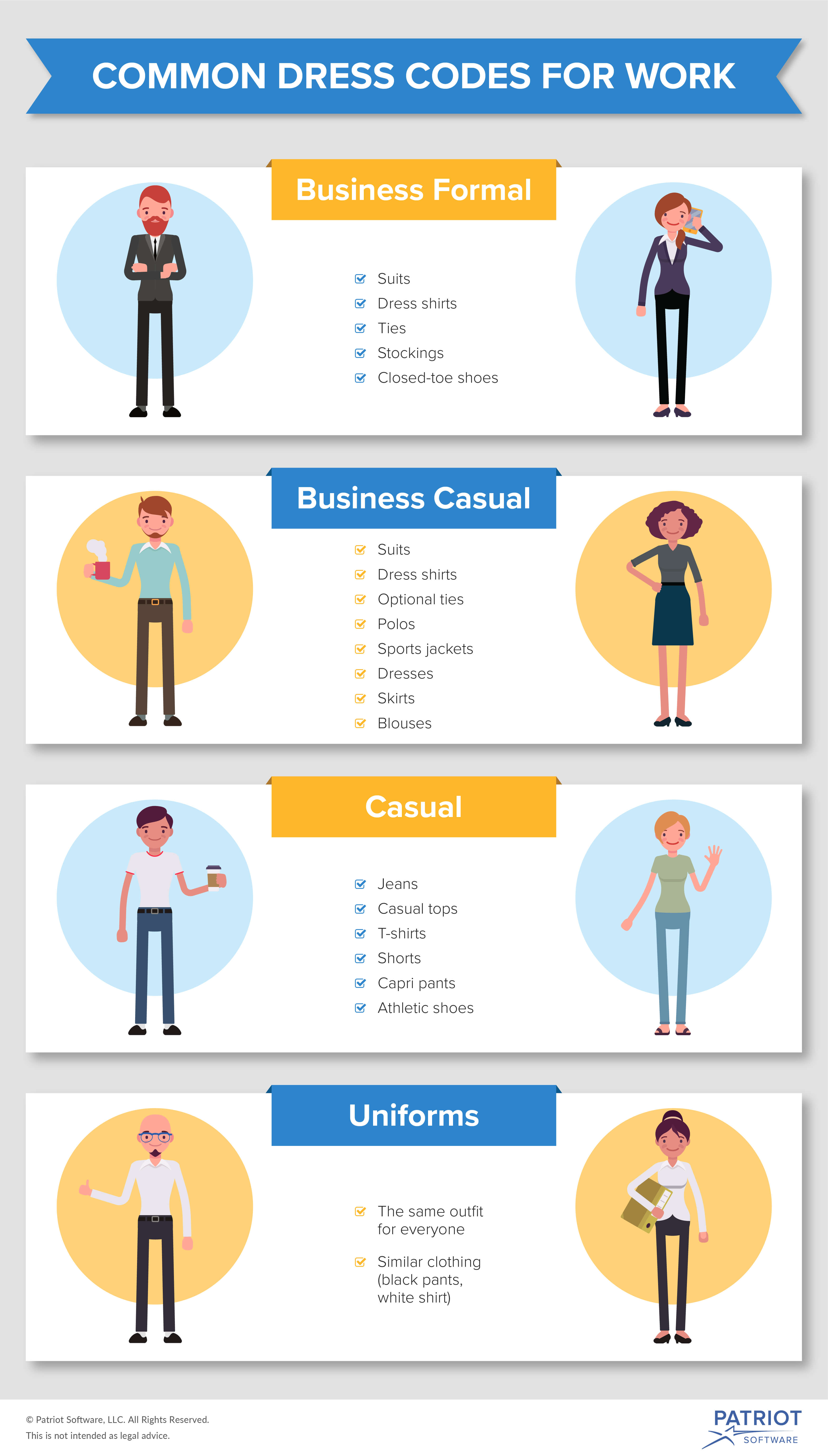Creating an employee dress code policy can be beneficial for your business. Dress codes can help you create your business’s image and keep employees safe. You can make your dress code policy for employees as formal or as casual as you want. But, there are some things you should consider when creating your policy.
Reasons to have a dress code policy
A workplace dress code policy might be a good choice for your business for numerous reasons.
Employee dress codes can improve employee safety. You can require employees to wear clothes that will protect them, such as steel-toe boots. You might also prohibit certain types of clothes that might cause a safety hazard, such as baggy clothes and jewelry that can get caught in a machine.
Setting a dress code can limit distractions and annoyances in the workplace. For example, you might prohibit revealing clothing or strong perfumes.
A dress code can improve your business’s brand awareness. Your employees are an extension of your brand. Having logos or similar attire can make your employees easily recognizable both inside and outside your business. A common dress code lets customers easily identify who is an employee.
Also, customers might expect a certain dress code in your industry. For example, if you have a consulting agency, customers might expect your employees to wear business formal or business casual clothes. If you run a hotel, customers might expect a common uniform among your staff.
Types of dress codes for work
There are common types of dress codes. You can use a common dress code for your business or create your own.
Here are some of the common dress codes you can choose from:
Business formal attire includes suits, dress shirts, ties, stockings, and closed-toe shoes.
Business casual attire includes suits, dress shirts, optional ties, polos, sports jackets, dresses, skirts, and blouses.
Casual attire includes jeans, casual tops, T-shirts, shorts, capri pants, and athletic shoes.
Uniforms are specific attire that you require employees to wear. You might order the same outfit for every employee. Or, you might ask all employees to wear similar clothing, such as black pants and white shirts. If you require employees to wear uniforms, make sure you follow the FLSA rules about uniforms.

Creating a company dress code policy
Make your company dress code clear to employees. Include it in your employee handbook so employees can easily reference it.
Your staff dress code policy should include:
- The types of clothing employees can wear
- Any grooming standards employees must follow
- Dress code examples
- Consequences for violating the policy
Legal considerations
No one federal law regulates employee dress codes and what you are allowed to put in your dress code policy.
However, federal laws about discrimination might affect your policy. And, your state might have specific employee dress code laws that you must follow.
When creating an employee dress code policy, you may want to consult a lawyer. And, it may be beneficial to talk to a lawyer as special situations arise, like when an employee asks for an accommodation.
Here are some things you should consider when making a dress code policy.
Religious expression
You might have to accommodate employees’ strongly held religious beliefs, as long as the exception doesn’t cause undue hardship. The EEOC requires these accommodations for businesses with at least 15 employees. If your dress code policy conflicts with an employee’s religious practices, they can request an accommodation.
Employees might seek accommodation for hair length, clothing, face coverings, and jewelry.
For example, you require men to be clean shaven for sanitary reasons. An employee says he cannot shave his beard because of his religious beliefs. You might be able to accommodate the employee and maintain EEO compliance by having him wear a beard cover.
Sex and gender identity
Your company dress code should not be more burdensome to one sex than the other. The dress and grooming standards should be relatively equal. For example, having certain rules only for women about hairstyles and colors, fingernails, and makeup might be seen as burdensome and unfair.
You should also consider accommodations based on gender identity. You might have to accommodate employees who express themselves as the opposite gender.
Disability
An employee can ask for a dress code accommodation for a disability. Some dress code requirements might not be possible for an employee with a disability. For example, an employee might ask to wear sneakers instead of the shoes listed in the policy because of a foot condition.
Race
You might need to consider race when creating your policy, especially in the grooming rules. For example, your policy on hairstyles should consider different hair textures that are found across races.
This is not intended as legal advice; for more information, please click here.
These views are made solely by the author.
